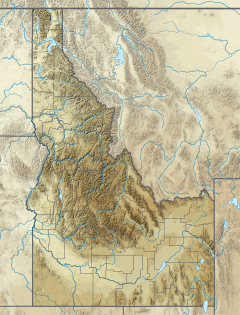Bruneau Dunes State Park is a public recreation and geologic preservation area in the western United States, located in Owyhee County in southwestern Idaho. It is northeast of Bruneau and fifteen miles (25 km) south of Mountain Home.
| Bruneau Dunes State Park | |
|---|---|
IUCN category V (protected landscape/seascape) | |
 Bruneau sand dunes and lake | |
Location in the United States Location in Idaho | |
| Location | Owyhee County, Idaho, U.S. |
| Nearest city | Mountain Home, Idaho |
| Coordinates | 42°54′36″N 115°42′35″W / 42.91°N 115.70972°W[1] |
| Area | 4,800 acres (19 km2)[1] |
| Elevation | 2,470 ft (750 m)[1] |
| Designation | Idaho state park |
| Established | 1967[2] |
| Administrator | Idaho Department of Parks and Recreation |
| Website | Bruneau Dunes State Park |
Featuring large sand dunes and small lakes, the state park is the site of North America's tallest single-structured sand dune, which is approximately 470 feet (140 m) in height.[3][A] The park encompasses 4,800 acres (7.5 sq mi; 19 km2) and features the Bruneau Dunes Observatory, where visitors can use a telescope for stargazing.[1]
Natural history
edit- Geology
The park's dunes are unique in the Western Hemisphere: where others in the Americas form at the edge of a natural basin, the Bruneau dunes form near the center. The basin has acted as a natural trap for over 12,000 years. The dunes may have started with sands from the Bonneville Flood about 15,000 years ago. With prevailing winds blowing from the southeast 28 percent of the time and from the northwest 32 percent of the time, the dunes stay fairly stable, and unlike most dunes, do not drift far.[4]
- Flora and fauna
The state park includes desert, dune, prairie, lake and marsh habitat. Desert wildlife is prominent along with birds of prey and waterfowl.[4]
Park history
editLand for the park was purchased under the Recreation and Public Purposes Act in May 1967. Additional acreage was acquired in 1980 and in 1984, bringing the park's total area to 4,800 acres (19 km2).[2]
Recreation
editActivities include sandboarding, fishing, birdwatching, camping, hiking, swimming, and viewing the stars at the public observatory. No motorized vehicles are allowed on the dunes but climbing and sledding are permitted. There are seven-mile (11 km) and nine-mile (14 km) horseback riding trails around the dunes. An educational center offers natural history displays and a gift shop. The astronomical observatory is open Friday and Saturday evenings mid-March through mid-October. Two cabins, 82 RV sites (with water/electricity) and 32 standard sites are available year round in two campgrounds: Eagle Cove Campground and Broken Wheel Campground. An equestrian overnight facility, with corrals, is also available.[1] Fishing for bass and bluegill is popular in the park's small lake. Only non-motorized canoes, rafts and float tubes are allowed.
See also
editNotes
edit- ^ The highest multistructured dune in North America is at Great Sand Dunes National Park and Preserve in Colorado and is approximately 750 feet (230 m) high.
References
edit- ^ a b c d e "Bruneau Dunes State Park". Idaho Parks and Recreation. Retrieved October 18, 2017.
- ^ a b "History: State Lands in Idaho". Idaho Museum of Natural History. Retrieved March 4, 2011.
- ^ Gallagher, Susan (September 8, 1985). "Idaho has America's tallest sand dune". Sunday Tribune. (Lewiston, Idaho). Associated Press. p. 3F.
- ^ a b "Bruneau Sand Dunes". Digital Atlas of Idaho. Idaho Museum of Natural History. Retrieved March 4, 2011.
External links
edit- Bruneau Dunes State Park Idaho Parks and Recreation
- Bruneau Dunes State Park Map Idaho Parks and Recreation
- Bruneau Dunes State Park at a database of DarkSky International

